Written by Clarice Yan and Zachary Chong
Worldwide, there are 26 extant flycatchers belonging to the genus Muscicapa. In Singapore, six species of the genus have been recorded here during the migratory season. Here, the Asian Brown Flycatcher M. dauurica is the most commonly sighted in relatively large numbers; Dark-Sided Flycatcher M. sibirica, Ferruginous Flycatcher M. ferruginea and Brown-streaked Flycatcher M. williamsoni are uncommon migrants occurring in smaller numbers. The Grey-streaked Flycatcher M. griseisticta is a very rare vagrant with the single record found at Sembawang this season. Lastly, the Spotted Flycatcher M. striata is also a vagrant with the single record this season at Kent Ridge Park.
Undoubtedly, these ‘brown jobs’ as they are affectionately termed are hard to differentiate. If we bump into them in the field, how do we know if we are looking at just another Asian Brown Flycatcher or the next mega sighting?
Ferruginous Flycatcher M. ferruginea
First, let’s look at the flycatcher most distinct from the rest – the Ferruginous Flycatcher. Often called “Iron Boy” by local photographers, this nickname is derived from its characteristic slaty-grey head combined with its orange-brown colouration and rusty-rufous fringes on its coverts and tertials. The rufescent rump, upper tail-coverts, tail and pink legs are also dead giveaways for the Ferruginous Flycatcher. In addition, the Ferruginous Flycatcher generally prefers dark, usually damp undergrowth in Singapore, unlike the other Muscicapa species mentioned, barring the occasional Dark-sided Flycatcher.
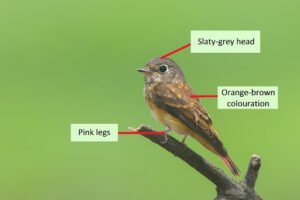
Spotted Flycatcher M. striata
One of the easiest features to pick out in the field for the Spotted Flycatcher is its thin, buff eye-ring as compared to the more white eye-ring in other flycatchers. The paler forehead, buff lores and distinctly streaked crown are also clear characteristics that separate the Spotted from other Muscicapa flycatchers.
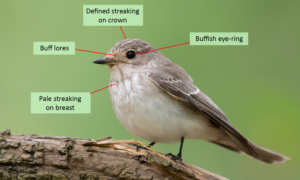
Asian Brown Flycatcher M. dauurica
The Asian Brown Flycatcher is an ashy-brown/grey-brown flycatcher with a bulky and strong-looking bill compared to other asian Muscicapa flycatchers. This species has broad white lores, and typically, a conspicuous and complete white eye-ring. The throat of this species is rather clean and the edge of its tertials are greyish-white.
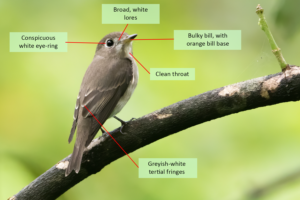
Brown-streaked Flycatcher M. williamsoni
In contrast to the Asian Brown Flycatcher, the Brown-streaked Flycatcher is warm-brown. This flycatcher also has less contrasting white lores, giving it a “plain-faced” appearance. Juveniles usually tend to have more defined brown streaks on the breast, upper belly and flanks (streaking may fade on adult Brown-streaked individuals). Its dusky throat, bulky bill with a more extensive yellow/orange bill base, and the occasional buffish eye-ring separate this species from the Asian Brown Flycatcher. The edges of the upper wing coverts of the Brown-Streaked Flycatcher are buffy. However, this trait is typically less distinct for adult individuals. Adult individuals tend to have less pronounced streaks on their breast and thinner fringes on their upperwing coverts.
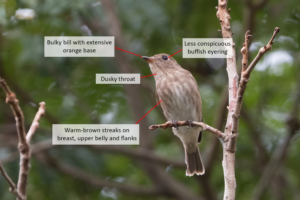
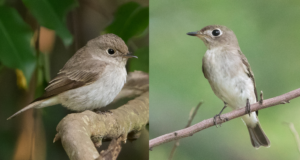
Dark-sided Flycatcher M. sibirica
The Dark-sided Flycatcher is cold grey and possesses a fine and small bill, which separates it from the other flycatchers. This species can have an incomplete eye-ring, which is more prominent at the back of the eye. The lores of the Dark-sided Flycatcher are also “dirtier”. The Dark-sided has a smudged greyish-brown breast and flanks, with heavy and dark streaking.
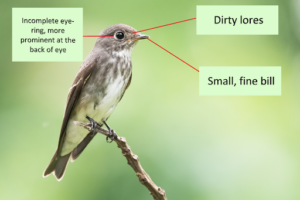
Grey-streaked Flycatcher M. griseisticta
The Grey-streaked Flycatcher is a cold grey coloured flycatcher, also possessing fine white lores and bill. Although similar to the Dark-sided Flycatcher, the Grey-streaked Flycatcher’s bill is longer than the Dark-sided, when viewed properly. This species can have a less conspicuous eye-ring. The Grey-streaked has defined, long pencil-like streaks on the breast and flanks, which differ greatly from the Dark-sided or Brown-streaked. The juvenile plumage for the Dark-sided and Grey-streaked Flycatchers are highly similar. In such cases, do consider the other traits listed above.
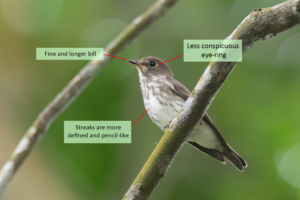
Given that the aforementioned four Muscicapa species, namely the Asian Brown, Brown-streaked, Dark-sided and Grey-streaked flycatchers, are relatively more difficult to tell apart, here is a table for summary.
| Trait | ABFC | BSFC | DSFC | GSFC |
| Plumage colour | Brown | Warmer brown than ABFC | Cold grey | Cold grey |
| Bill | Bulky bill, orange on bill base | Bulky bill, more extensive orange on bill base than ABFC | Fine, short bill | Fine, longer bill than DSFC |
| Eye-ring | Conspicuous white eye-ring | Occasionally buffish | Less conspicuous white eye-ring, may appear incomplete in comparison to ABFC | Less conspicuous white eye-ring, may appear incomplete in comparison to ABFC |
| Lores | Broad and clean white lores | Buffy, dirtier lores compared to ABFC | Dirty lores | Fine white lores |
| Chin | White | Dusky | White | White |
| Streaks on underparts | Generally absent | Heavy brown streaking on juveniles, less conspicuous and sometimes absent on adults | Smudged flanks, sometimes smudged streaking on breast | Fine, distinct streaks on breast and flanks |
| Edges to upper wing coverts | Greyish-white | Distinctly buffish | Buffish-white | Whitish |
Further Traits: Wing Length
Wing length (and wing/tail ratio) increases from Asian Brown and Brown-streaked to Dark-sided and then Grey-streaked (Harris et al., 2014). This also leads to a progressively more pointed wing shape which can be observed; Asian Brown and Brown-streaked tend to have a more rounded wing shape and appearance.
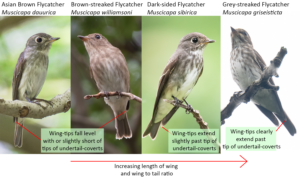
One other Muscicapa possibility
Now that we’ve covered the flycatchers that have been sighted in Singapore so far, we can turn our attention to a potential flycatcher that may someday make its way down south to Singapore. The Brown-breasted Flycatcher M. muttui is resident to India, China, Sri Lanka and is a visitor to Thailand, Tonkin, Myanmar, Laos (Robson, 2015). It is superficially similar to Asian Brown but is larger and has a broad whitish eye-ring, rufescent upperparts, greyish-brown crown and ear-coverts and warm greyish-brown breast/flanks. It could potentially show up in Singapore so keep a look out for this next possible mega!
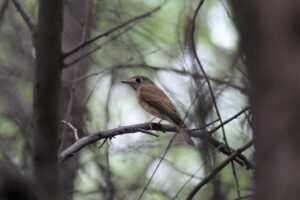
We hope that this article helps in differentiating the many Little Brown Jobs you may encounter in the field in the coming months! Do keep a lookout for future articles about other Little Brown Jobs, and happy birding!
Acknowledgements
Thanks to the team for their thorough comments and help with this writeup, and also for providing the photos.
References
Harris, J. B. C., Rasmussen, P. C., Yong, D. L., Prawiradilaga, D. M., Putra, D. D., Round, P. D., & Rheindt, F. E. (2014). A New Species of Muscicapa Flycatcher from Sulawesi, Indonesia. PLOS ONE, 9(11), e112657. https://doi.org/10.1371/journal.pone.0112657
Leader, P. J. (2010). Brown, Siberian and Grey-streaked Flycatchers: Identification and ageing. British Birds, 14. Link: http://britishbirds.co.uk/wp-content/uploads/2014/05/V103_N11_P658%E2%80%93671_A.pdf
Robson, C. (2015). A Field Guide to the Birds of South-East Asia Second Edition. New Holland Publishers.
Further notes:
- Edited 16 January 2022: The comparison photo of the adult Brown-streaked Flycatcher and the Asian Brown Flycatcher was edited (adjustment of white balance) to better reflect the warm tones of the adult Brown-streaked Flycatcher individual.
